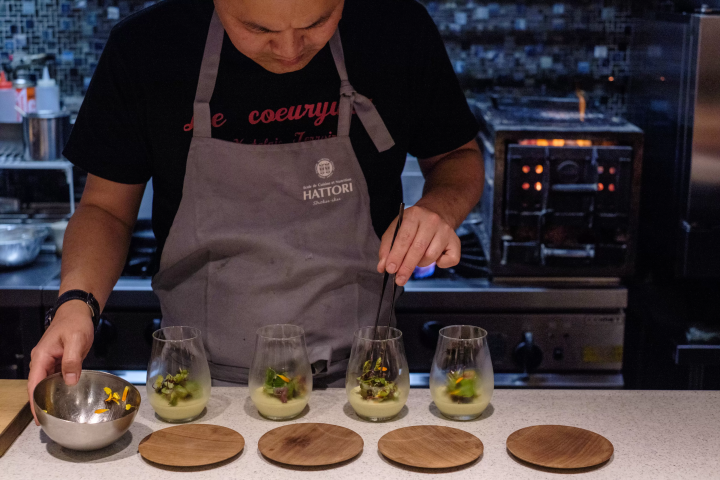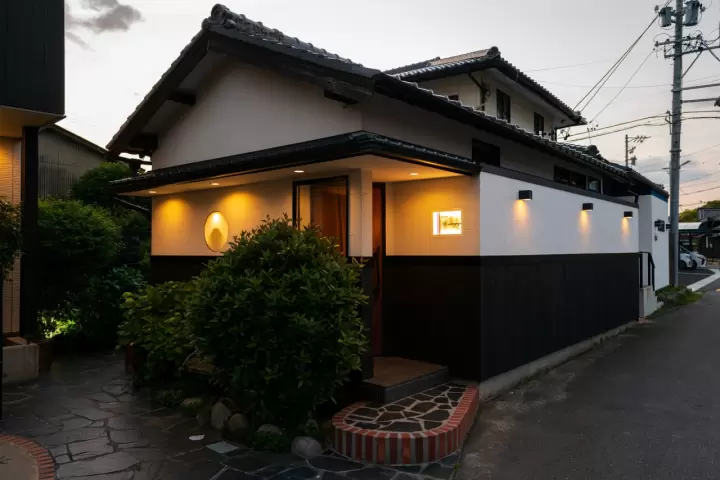At Le Coeuryuzu, a French restaurant on the Chita Peninsula in Aichi Prefecture, Chef Daisuke Watanabe offers a unique omakase experience featuring local ingredients and the region’s rich fermentation culture. Don't miss this exclusive culinary journey—available only here and now in Tokoname, Aichi.
2025.07.29Le coeuryuzu (pronounced lū-kuryuzu) is a French-inspired, locally-sourced restaurant located on the Chita Peninsula in Aichi Prefecture, just 20 minutes from Chubu Centrair International Airport by taxi.
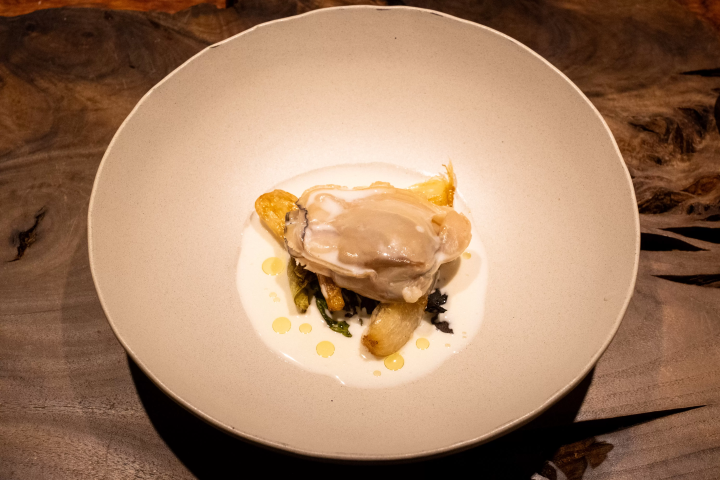
With its refined yet unpretentious atmosphere, Le coeuryuzu was established in 2017 by Chef Daisuke Watanabe, a recipient of the Ministry of Agriculture, Forestry and Fisheries’ “Cuisine Masters Bronze Award” in recognition of his contributions to Japanese food culture through local sourcing and close collaboration with producers.
Born in Iwate Prefecture and now living in the Chita Peninsula—an area blessed with both ocean and mountain bounty—Chef Watanabe has developed a keen sensitivity to regional flavor differences through his exposure to high-quality local ingredients. Surrounded by rich natural beauty, his interest in cooking began early on. A pivotal moment came when he attempted to prepare fish he had caught himself, marking the starting point of his journey to becoming a chef.
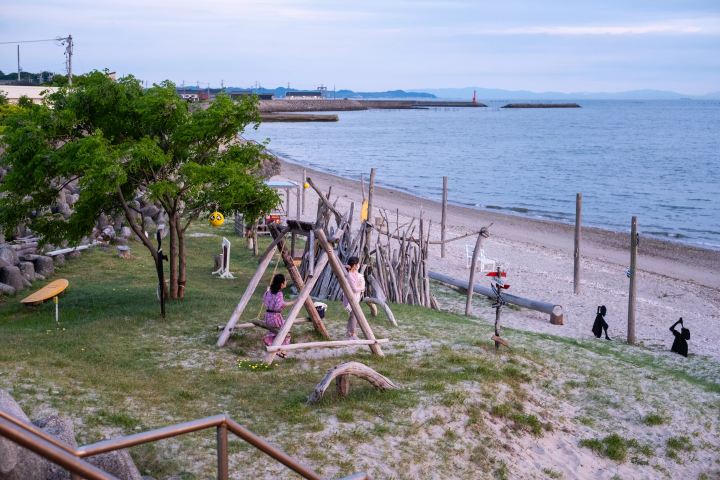
The seaside of Ise Bay, just steps away from Le coeuryuzu, serves as a source of inspiration for Chef Watanabe and offers guests a chance to connect with the natural beauty of the Chita Peninsula before their meal.
After training at a long-established French restaurant in Nagoya, Chef Watanabe honed his craft through experience at wedding venues and restaurants, as well as through self-study. Over time, he developed his own unique style—blending traditional French cuisine with elements of the local food culture.
His culinary philosophy is deeply rooted in the concept of “local production for local consumption.” He strives to use locally sourced ingredients whenever possible and is constantly exploring new ways to offer a truly unique, once-in-a-lifetime dining experience that reflects the flavors of that specific day and moment.
Another unique charm of this restaurant lies in its open kitchen, where guests can watch as Chef Watanabe prepares each dish right in front of them across the counter—creating an intimate and engaging dining experience.
The menu is planned daily, using almost exclusively seasonal ingredients (around 90% or more) sourced from trusted local producers with whom Chef Watanabe has cultivated long-established relationships. Even the plates and tableware are designed by Watanabe in collaboration with local master producers.
Aichi Prefecture, the Chita and Taketoyo area in particular, is one of the epicenters of hakko (fermentation) in Japan. Drawing on this local heritage, Chef Watanabe skillfully incorporates traditional Japanese fermented ingredients such as tamari soy sauce, vinegar, and mirin, alongside Western elements like house-made yogurt and Toyohashi butter, to create a well-balanced and innovative course menu.
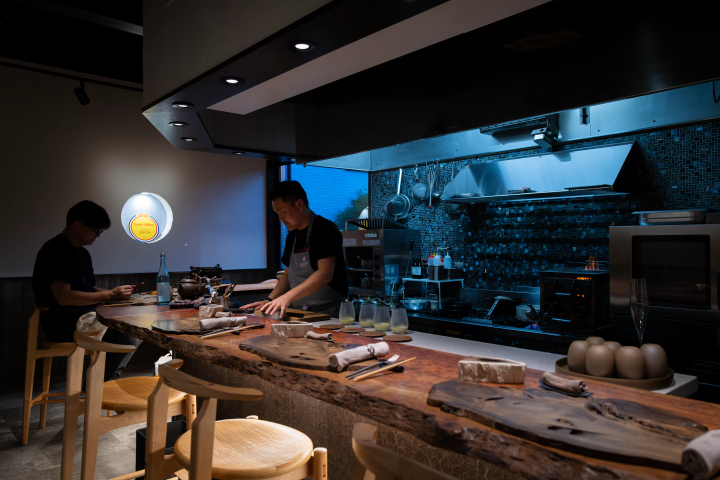

Chef Watanabe opened Le coeuryuzu in 2017 together with his wife, Kana.
We traveled to the Chita Peninsula to enjoy a meal prepared at Le coeuryuzu by Chef Watanabe. There, he discussed the finer points of both hakko culture and the many ways he integrates unique ingredients into his spectacular, locally-sourced menu.
Can you explain the meaning behind your concept Chisanchishō (lit. local producers, local consumption) in more detail?
The real meaning of Chisanchishō is about bringing everything that grows in this area together in a meal. The water, the air, the soil — everything. That’s how a true [culinary] affinity is born. The meaning behind cooking comes from the unique deliciousness provided by the region itself. I think of it as returning to a time when we all consumed the ingredients grown in our own land and soil.
Even the seasons here have their own unique smell in the air outside. Occasionally, the smell of the air in a particular season will bring back a memory of that time of year in my childhood and the dishes I ate. I’ll think to myself, “Ah, I ate sanma (Pacific Saury) in this season.”
So it’s all connected to a sense of place and seasonality.
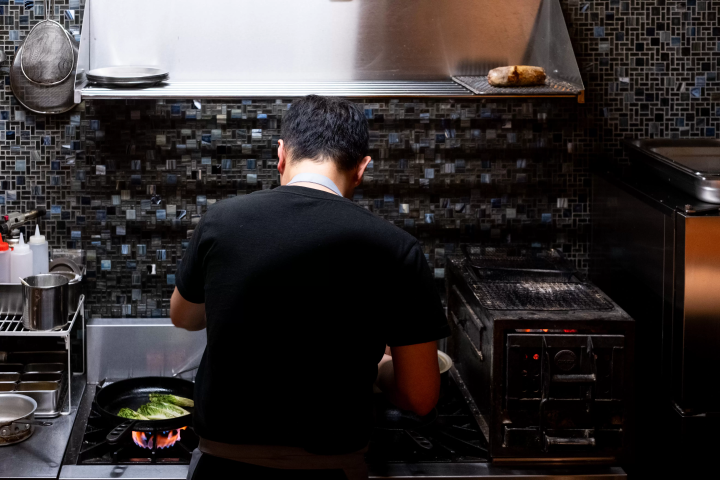
You are a largely self-taught chef who uses predominantly local ingredients — so how would you describe your style of cuisine?
Although I have studied and trained in French culinary traditions, the food I make is Chita Peninsula cuisine.
Do you ever have the desire to add exotic ingredients from outside the Chita Peninsula or even from outside of Japan into your dishes?
I always have that urge. [laughs] But then I think to myself: Well, if you do that, you might as well just go to Tokyo or France to open a restaurant.
The idea here is to create dishes that can only be found here and are made with ingredients from here. And once I committed to doing it, I found those outside ingredients weren’t necessary anymore.
The limitation of ingredients gives it meaning and a purpose — I want to protect that meaning. Not having everything available to me actually opens up my creative urges. If I could just use whatever I wanted, I may not be able to decide exactly what I want to do.
But there’s so much choice here. Many say the Chita Peninsula has some similarities to Italy, being near the ocean, so actually Italian vegetables like olives grow well here. The artichoke we served tonight is from my own field. And with fish going for half the price of Nagoya, the richness and quality of local ingredients are truly abundant. That’s exactly why we can create dishes unique to this land.
What is Hakko?
In Japan, there are two fundamentally different types of hakko:
There’s the fermented food culture of mountainous regions where the variety of hakkobutsu (fermented foods) was born out of a necessity to preserve the food during the harsh winters.
Another one is the fermented food culture that developed in what is now Aichi Prefecture. It originally emerged as a means of survival—people produced and sold these goods in Edo (present-day Tokyo) to earn a living. While not absolutely essential, these fermented products enrich both cooking and daily life, which is what makes them so special.
Any considerations regarding quality and the way that fermented ingredients are made are heavily influenced by these two backgrounds.
When creating Le coeuryuzu’s menu, do you find the ingredients that inspire the dishes first, or do you seek out ingredients based on the particular dish you want to make?
Both! Sometimes I’ll decide I want to use an ingredient such as shiro shoyu (a local white soy sauce) and traditional local vegetables and create a dish around that. Sometimes I have the dish in mind and realize that adding a specific ingredient will complete it.
When I was much younger, if I was in Nagoya or a big city, I would choose what I wanted to make and seek out the ingredients. Now it’s mostly the opposite. I find the most delicious seasonal ingredients and use a minimal amount of technique to bring out their natural delicious qualities. I started doing this in my 30s, I’m 46 now. At the time, I felt I could make the food look really beautiful, but it didn’t move me. I wanted to make food that would be emotionally moving to both me and those enjoying it.
There’s currently a tourism boom in Japan. If a celebrity or influencer posted a meal from Le coureyuzu and it went viral, how would you feel?
That’s my worst nightmare! [laughs] I don’t want to draw too much attention to myself. I want people to know more about the Chita Peninsula and all it has to offer: its shops, its culture, its history, and I hope I can encourage them to visit the area. So, essentially, [Le coeuryuzu] acts as a tourist information center.
I want to attract people who are excited to really get to know the area. Maybe after a meal here they say, “Tomorrow we should go to another place and try this.” Whether they visit from abroad or from within Japan, I want this place filled with people who can cherish the value of this land.
I don’t really care if my restaurant is famous because it’s featured in a guidebook or even for its reputation. I want people who think, I’m going to come back, and next time I’ll go somewhere else in the Chita Peninsula.
For those coming just because it’s fashionable? I would politely say, “No, thank you.” [laughs]
Here is a detailed introduction to a menu at Le coeuryuzu on this day.
When we visited at the end of May, the dishes served were fresh and vibrant, reminiscent of the lush greenery of early summer. However, Chef Watanabe explained that because he prepares meals using locally sourced ingredients available each season, sometimes the colors may be more brown or less vivid depending on the time of year. This reflects his commitment to the principles of seasonality and local production for local consumption. Experiencing the changing seasons through the appearance and taste of the dishes is something quite rare to find elsewhere.
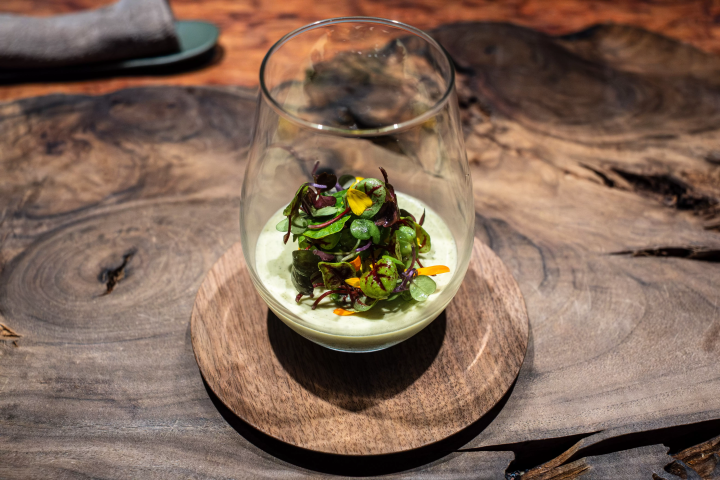
Appetizers
This zucchini mousse, garnished with edible flowers from Minamichita Town, located near Tokoname City, was a refreshing highlight. When I visited in early summer, the temperatures were gradually rising. That’s why, with just one bite, the coolness combined with the fresh aroma of zucchini gave me a sensation like a gentle, refreshing breeze. Since the ingredients used in the dishes are locally sourced, each bite allows you to fully enjoy the freshness through the texture and fragrance of the produce.
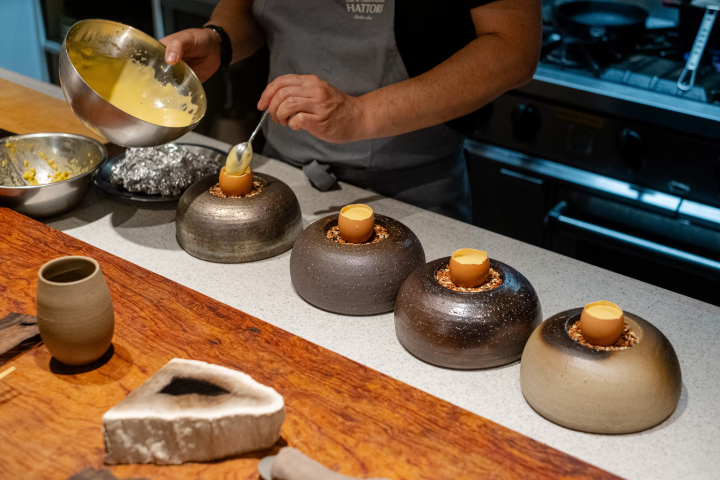
The first egg dish
The eggs used come from chickens raised on locally grown rice in Tokoname. Inside a real eggshell, you’ll find scrambled eggs with a seaweed purée, accompanied by a sabayon sauce with a tangy vinegar accent. What truly stands out is the presentation: to convey the story of “eggs from rice-fed chickens,” the eggshell is served atop a plate layered with seven different colors of rice. This attention to storytelling in each dish reflects Chef Watanabe’s passion and deep love for his hometown.
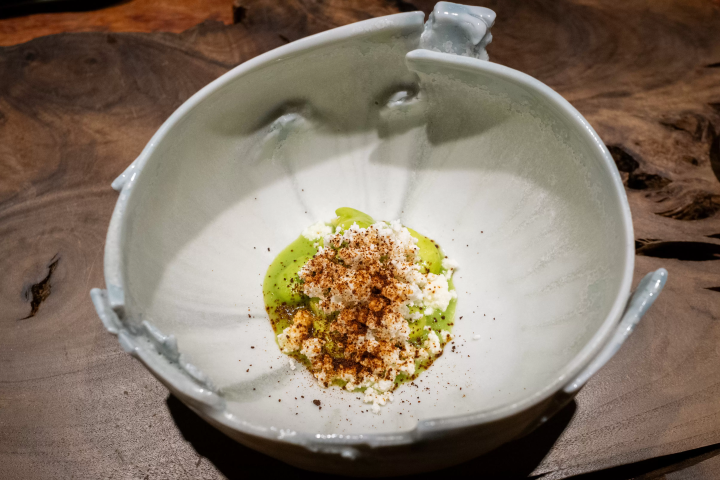
The second dish was served on a plate as artistic as a work of art.
This dish features locally sourced fresh broad beans topped with cheese made from Tokoname milk and tamari soy sauce turned into a powder. It is then finished with olive oil produced from olives grown on the Chita Peninsula. By using powdered tamari soy sauce from Nakasada Shoten, located in neighboring Taketoyo Town, the rich and deep umami flavor of the tamari is enhanced, bringing out the natural taste of the ingredients even more.
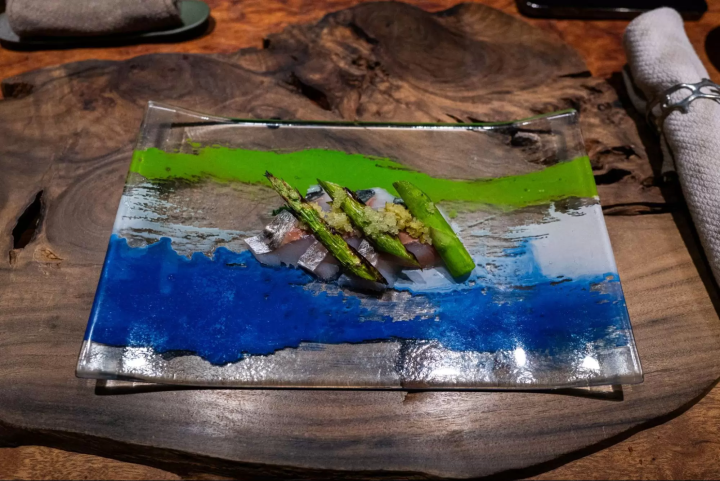
The third course showcased a stunning harmony between the dish and the colors of the plate.
This dish features horse mackerel and asparagus, accompanied by finger lime caviar and salted kabosu citrus. Finger lime, originally from Australia, is a rare citrus fruit I encountered for the first time during this interview. It has a slender shape and tiny, bead-like pulp, often called “citrus caviar.” Its popping texture and refreshing acidity add a unique accent to the dish. Interestingly, Chef Watanabe discovered this particularly rare ingredient in Japan by chance on Instagram, where he found out that a farmer in Toyohashi City, Aichi Prefecture, is cultivating it. This story left a strong impression, showcasing the chef’s passionate curiosity about food.
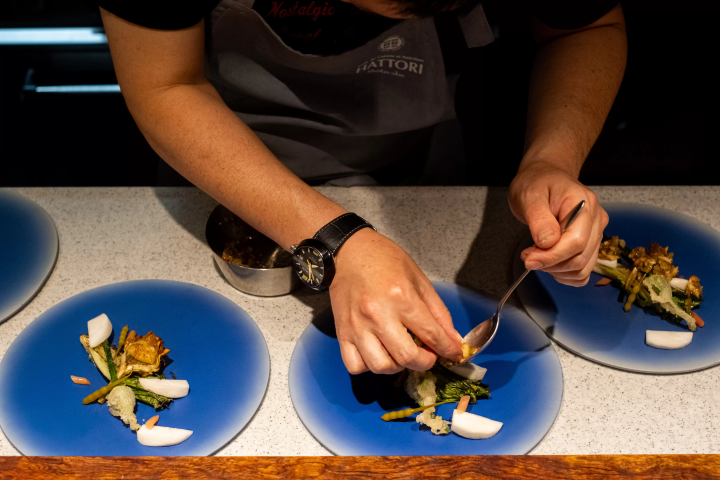
A dish starring vegetables harvested from the chef’s own farm.
This dish features romaine lettuce, artichokes harvested from the chef’s farm, tempura of garlic shoots, and raw turnips accompanied by pickled coastal radish and coastal fennel. The coastal radish and fennel were foraged directly by the chef from the nearby shores of Tokoname, without going through any producers, making this truly a dish filled with locally sourced ingredients handpicked by the chef himself.
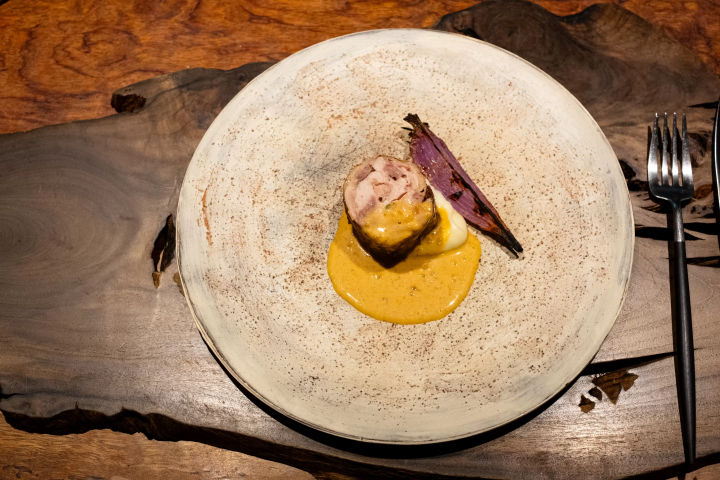
Main meat dish
This dish features a roulade of guinea fowl thigh meat stuffed with gizzard, liver, and heart, served with a curry-flavored sauce. By enjoying various parts of the bird in one bite, you can experience a delightful contrast of textures. The exotic aroma of the curry pairs perfectly with the richness of the meat.
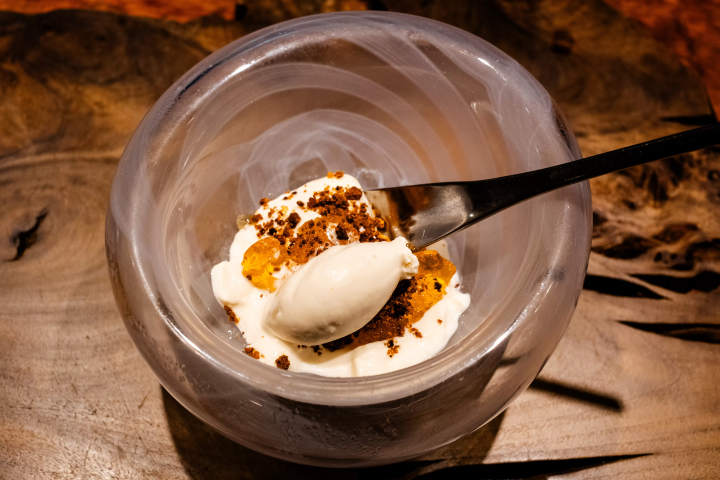
Dessert
This dessert features a lemon myrtle-flavored blancmange served with plum jelly and homemade yogurt ice cream, topped with crushed cookies and nuts. The refreshing yet rich and creamy flavors of the blancmange and ice cream are perfectly balanced by the sharp acidity of the plum jelly. Each element comes together in exquisite harmony, creating a truly exceptional dessert unlike any I have ever tasted before.
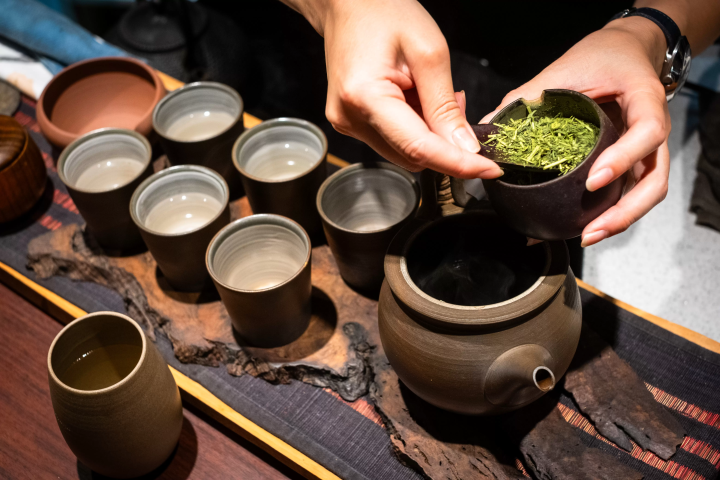
Locally fired Tokoname-yaki tea ware from Tokoname.
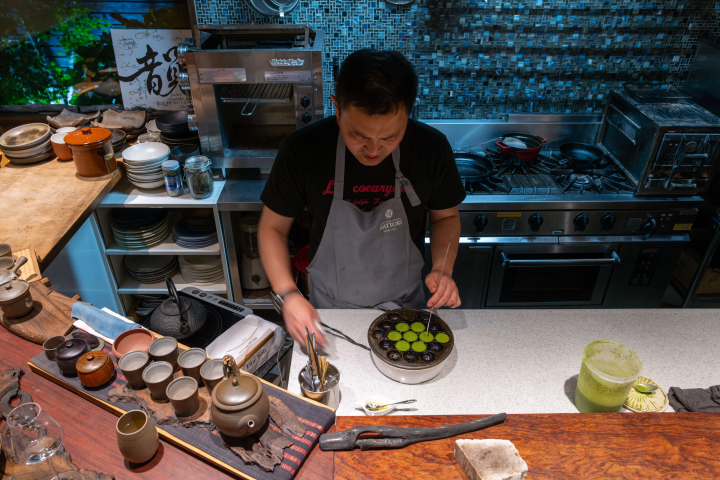
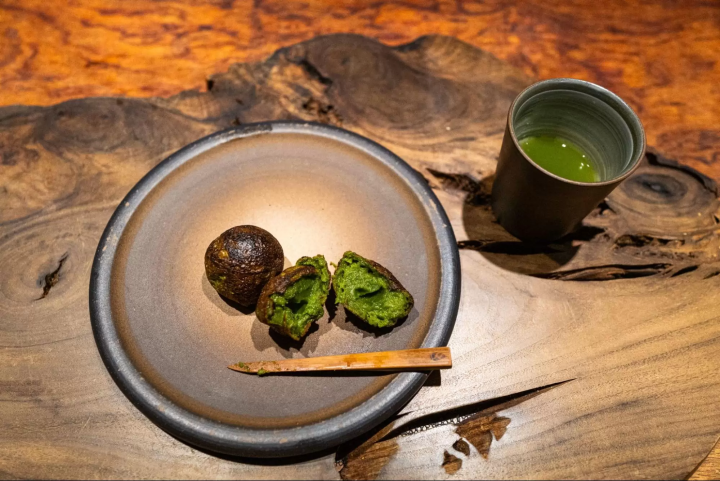
The course ends with tea and traditional sweets.
Le coeuryuzu creates and serves unique dishes that change daily—never to be repeated again. However, one thing that remains constant is their use of matcha from Nishio, Aichi, which is incorporated into the crepe batter to make their signature crepe balls, served alongside locally produced sencha from Tokoname.
Though the cuisine is sophisticated, the crepe balls are surprisingly cooked in a takoyaki pan—a common household tool—resulting in a chewy and moist texture unlike any other. This texture wonderfully enhances the aroma of the matcha in a mysterious way. The sencha, with its gentle sweetness and subtle fragrance, provided a comforting and heartwarming finish.
At Le coeuryuzu, where innovation and new culinary creations are constantly pursued, this dish beautifully expresses the warm hospitality that remains at the heart of the dining experience.
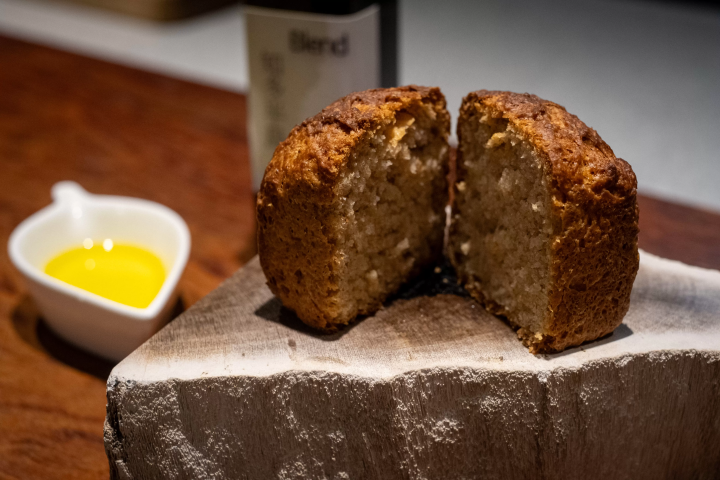
During the meal, delicious homemade bread was also served. The bread is made by Chef Watanabe’s partner, Kana Watanabe, using local ingredients such as butter produced in Toyohashi, homemade yogurt, and wheat flour from Aichi Prefecture. The crust is crispy while the inside is perfectly moist, featuring a rich buttery aroma balanced by a clean, refreshing taste.
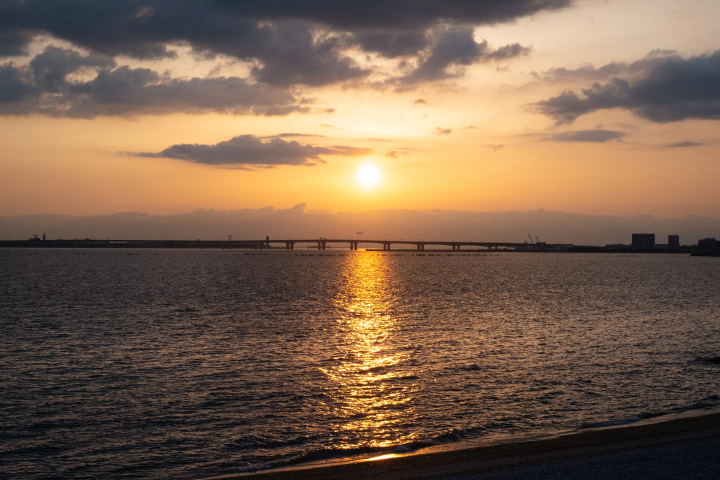
The view of Ise Bay at dusk, spreading out behind Le coeuryuzu.
summary
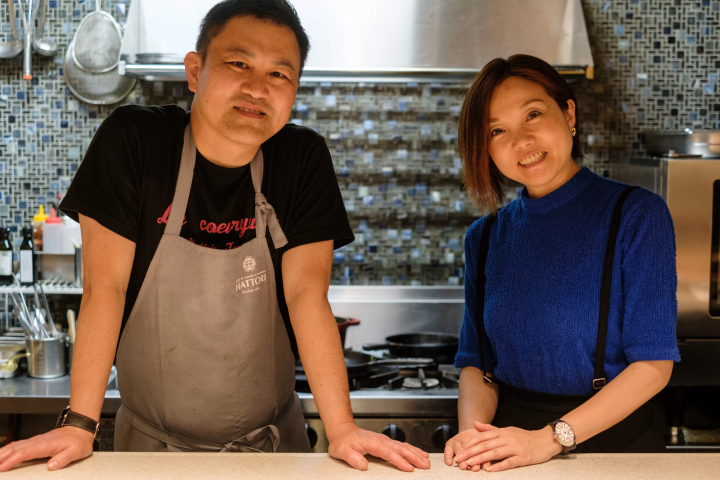
At Le coeryuzu, guests can enjoy watching their omakase locavore meal prepared by Chef Watanabe in real time in front of them. They can be sure that every ingredient has been carefully selected by Chef Watanabe from local producers with whom he has a long-standing relationship, or those he has sourced himself from his own garden or very recent travels.
The result is a colorful, beautifully presented, ever-changing experience where the only constant is Chef Watanabe and his partner, Kana, working in tandem to keep courses coming and conversations flowing with guests — be they first-timers or the more familiar jōren (repeat customers) who keep coming back to try the latest culinary creations.
The result is always a thoughtful, one-of-a-kind meal that could only be experienced at Le coeuryuzu and in the Chita Peninsula.
Le coeuryuzu operates by reservation only. With limited seating available, we recommend booking early through this page (language options available).
The contents on this page may partially contain automatic translation.

